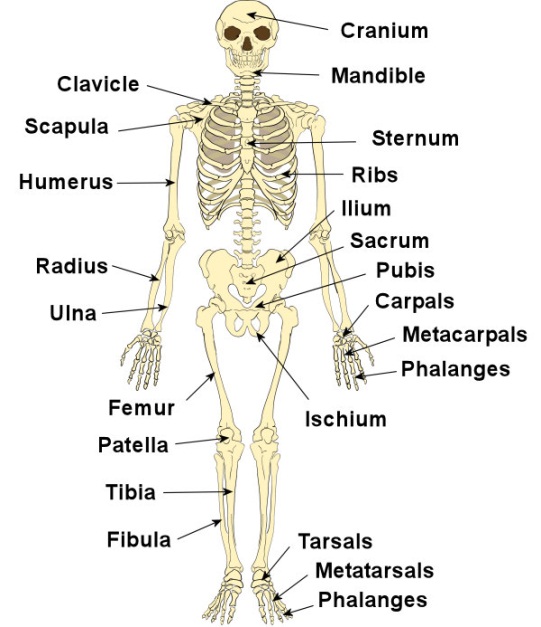The skeleton provides the framework of the body and it is made up of 206 bones. It is part of the skeletal system, which is composed of ligaments and cartilages, in addition to bones. Bones are connective tissues made of osseous materials that undergo calcification, a process where minerals are deposited to harden the bone. Cartilages are thick and rubbery tissues that are found in joints, the ears, the nose, and the ribs. Ligaments are tough, fibrous tissues that connect one bone to another bone, while tendons are soft tissues that connect muscles to bones.
Aside from providing the body framework, there are other functions of the skeleton. Inside the long bones are blood vessels and bone marrow, which is composed of various cells including fat cells, nerve cells, and other connective tissue cells. The important functions include providing body shape, support, and protection, allowing body movement, and supporting blood formation and electrolyte and acid-base balance.
Functions of the Skeleton
The important functions make the human body superior to other living species. The human skeleton has special features, such as having opposable thumbs and walking erect on two legs, which make man unique and highly functional. To appreciate these, let us take a look at the vital functions of the skeleton:
- Shape. The shape of the body is determined by the skeletal framework. Your body shape develops as the skeletal system develops, making you look tall, short, narrow or wide. The size and shape of your hips, hands, feet, and other body parts also follow the shape of your skeleton. These characteristics may be genetically inherited and these are classified as body types such as ectomorphs (thin and tall), mesomorphs (muscular and short), and endomorphs (apple/pear-shaped).
- Support. Your skeleton supports the body and holds your internal organs in place. The spine or vertebral column lets you stand erect while other bones form hollow spaces to hold organs inside them. Your skull, for example, holds your brain, while your chest cavity contains your heart and lungs. On the other hand, the legs and feet, which are part of the lower appendages, support the body weight.
- Movement. The bones are attached to other bones and muscles by ligaments and tendons and work together to produce various body movements, making up the musculoskeletal system. Muscles contract and pull bones to produce movements such as walking, running, or lifting. The differences in shapes of the bones play a role in differentiating movements. For example, the small bones in the foot allow you to adapt to walking different terrains, while the small bones of the hands allow you to do detailed, precise movements.
- Protection. The bony skeleton encases vital organs and protects them from damage. The skull protects the brain, while the spinal column protects the spinal cord and nerves. The ribs and sternum comprise the thorax, which protect your lungs and heart.
- Blood Cell Production. Long bones contain spongy tissue, which is composed of two types of bone marrow involved in the production of blood cells. Red marrow develops into blood cells. Yellow marrow stores some fat, which develops into red marrow during anemia or severe depletion of red blood cells.
- Storage. Skeletal bones store minerals like phosphorus and calcium. These minerals are involved in many important body functions, such as metabolism and nerve transmission.
- Endocrine Regulation. Recent studies show that one of the functions of the skeleton is endocrine regulation. Bones have been found to participate in controlling weight and sugar metabolism, which can help prevent the development of type 2 diabetes. The skeleton releases osteocalcin, a hormone that helps in blood sugar regulation and fat distribution. This hormone also increases insulin production and function, which is important hormone in blood sugar metabolism, and reduces fat accumulation.
- Electrolyte Balance. Electrolytes like calcium and phosphate are stored in the skeletal system. These may be released into the circulation to help maintain electrolyte balance.
- Acid-Base Balance. Bone may act as buffers that protect the body from drastic changes in levels of acidity or pH.
This list of functions of the skeleton shows that your bones do not just serve as a framework to support the body but they also participate in maintaining other important body functions.
